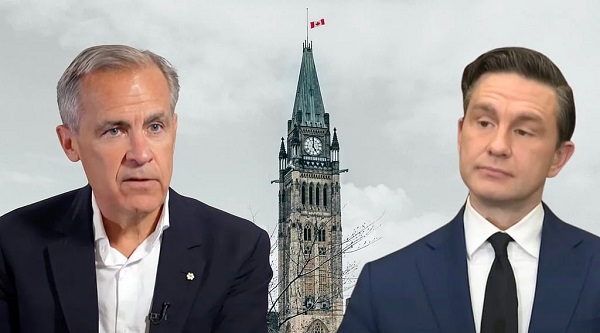Business
New airline compensation rules could threaten regional travel and push up ticket prices

New passenger compensation rules under review could end up harming passengers as well as the country’s aviation sector by forcing airlines to pay for delays and cancellations beyond their control, warns a new report published this morning by the MEI.
“Air travel in Canada is already unaffordable and inaccessible,” says Gabriel Giguère, senior public policy analyst at the MEI. “New rules that force airlines to cover costs they can’t control would only make a bad situation worse.”
Introduced in 2023 by then-Transport Minister Omar Alghabra, the proposed amendment to the Air Passenger Protection Regulations would make airlines liable for compensation in all cases except those deemed “exceptional.” Under the current rules, compensation applies only when the airline is directly responsible for the disruption.
If adopted, the new framework would require Canadian airlines to pay at least $400 per passenger for any “unexceptional” cancellation or delay exceeding three hours, regardless of fault. Moreover, the definition of “exceptional circumstances” remains vague and incomplete, creating regulatory uncertainty.
“A presumed-guilty approach could upend airline operations,” notes Mr. Giguère. “Reversing the burden of proof introduces another layer of bureaucracy and litigation, which are costs that will inevitably be passed on to consumers.”
The Canadian Transportation Agency estimates that these changes would impose over $512 million in additional costs on the industry over ten years, leading to higher ticket prices and potentially reducing regional air service.
Canadians already pay some of the highest airfares in the world, largely due to government-imposed fees. Passengers directly cover the Air Travellers Security Charge—$9.94 per domestic flight and $34.42 per international flight—and indirectly pay airport rent through Airport Improvement Fees included on every ticket.
In 2024 alone, airport authorities remitted a record $494.8 million in rent to the federal government, $75.6 million more than the previous year and 68 per cent higher than a decade earlier.
“This new regulation risks being the final blow to regional air travel,” warns Mr. Giguère. “Routes connecting smaller communities will be the first to disappear as costs rise and they become less profitable.”
For instance, a three-hour and one minute delay on a Montreal–Saguenay flight with 85 passengers would cost an airline roughly $33,000 in compensation. It would take approximately 61 incident-free return flights to recoup that cost.
Regional air service has already declined by 34 per cent since 2019, and the added burden of this proposed regulation could further reduce connectivity within Canada. It would also hurt Canadian airlines’ competitiveness relative to U.S. carriers operating out of airports just south of the border, whose passengers already enjoy lower fares.
“If the federal government truly wants to make air travel more affordable,” says Mr. Giguère, “it should start by cutting its own excessive fees instead of scapegoating airlines for political gain.”
You can read the Economic Note here.
* * *
The MEI is an independent public policy think tank with offices in Montreal, Ottawa, and Calgary. Through its publications, media appearances, and advisory services to policymakers, the MEI stimulates public policy debate and reforms based on sound economics and entrepreneurship.
Business
Will the Port of Churchill ever cease to be a dream?

From Resource Works
The Port of Churchill has long been viewed as Canada’s northern gateway to global markets, but decades of under-investment have held it back.
A national dream that never materialised
For nearly a century, Churchill, Manitoba has loomed in the national imagination. In 1931, crowds on the rocky shore watched the first steamships pull into Canada’s new deepwater Arctic port, hailed as the “thriving seaport of the Prairies” that would bring western grain “1,000 miles nearer” to European markets. The dream was that this Hudson Bay town would become a great Canadian centre of trade and commerce.
The Hudson Bay Railway was blasted across muskeg and permafrost to reach what engineers called an “incomparably superior” harbour. But a short ice free season and high costs meant Churchill never grew beyond a niche outlet beside Canada’s larger ports, and the town’s population shrank.
False starts, failed investments
In 1997, Denver based OmniTrax bought the port and 900 kilometre rail line with federal backing and promises of heavy investment. Former employees and federal records later suggested those promises were not fully kept, even as Ottawa poured money into the route and subsidies were offered to keep grain moving north. After port fees jumped and the Canadian Wheat Board disappeared, grain volumes collapsed and the port shut, cutting rail service and leaving northern communities and miners scrambling.
A new Indigenous-led revival — with limits
The current revival looks different. The port and railway are now owned by Arctic Gateway Group, a partnership of First Nations and northern municipalities that stepped in after washouts closed the line and OmniTrax walked away. Manitoba and Ottawa have committed $262.5 million over five years to stabilize the railway and upgrade the terminal, with Manitoba’s share now at $87.5 million after a new $51 million provincial pledge.
Prime Minister Mark Carney has folded Churchill into his wider push on “nation building” infrastructure. His government’s new Major Projects Office is advancing energy, mining and transmission proposals that Ottawa says add up to more than $116 billion in investment. Against that backdrop, Churchill’s slice looks modest, a necessary repair rather than a defining project.
The paperwork drives home the point. The first waves of formally fast tracked projects include LNG expansion at Kitimat, new nuclear at Darlington and copper and nickel mines. Churchill sits instead on the office’s list of “transformative strategies”, a roster of big ideas still awaiting detailed plans and costings, with a formal Port of Churchill Plus strategy not expected until the spring of 2026 under federal–provincial timelines.
Churchill as priority — or afterthought?
Premier Wab Kinew rejects the notion that Churchill is an afterthought. Standing with Carney in Winnipeg, he called the northern expansion “a major priority” for Manitoba and cast the project as a way for the province “to be able to play a role in building up Canada’s economy for the next stage of us pushing back against” U.S. protectionism. He has also cautioned that “when we’re thinking about a major piece of infrastructure, realistically, a five to 10 year timeline is probably realistic.”
On paper, the Port of Churchill Plus concept is sweeping. The project description calls for an upgraded railway, an all weather road, new icebreaking capacity in Hudson Bay and a northern “energy corridor” that could one day move liquefied natural gas, crude oil, electricity or hydrogen. Ottawa’s joint statement with Manitoba calls Churchill “without question, a core component to the prosperity of the country.”
Concepts without commitments
The vision is sweeping, yet most of this remains conceptual. Analysts note that hard questions about routing, engineering, environmental impacts and commercial demand still have to be answered. Transportation experts say they struggle to see a purely commercial case that would make Churchill more attractive than larger ports, arguing its real value is as an insurance policy for sovereignty and supply chain resilience.
That insurance argument is compelling in an era of geopolitical risk and heightened concern about Arctic security. It is also a reminder of how limited Canada’s ambition at Churchill has been. For a hundred years, governments have been willing to dream big in northern Manitoba, then content to underbuild and underdeliver, as the port’s own history of near misses shows. A port that should be a symbol of confidence in the North has spent most of its life as a seasonal outlet.
A Canadian pattern — high ambition, slow execution
The pattern is familiar across the country. Despite abundant resources, capital and engineering talent, mines, pipelines, ports and power lines take years longer to approve and build here than in competing jurisdictions. A tangle of overlapping regulations, court challenges and political caution has turned review into a slow moving veto, leaving a politics of grand announcements followed by small, incremental steps.
Churchill is where those national habits are most exposed. The latest round of investment, led by Indigenous owners and backed by both levels of government, deserves support, as does Kinew’s insistence that Churchill is a priority. But until Canada matches its Arctic trading rhetoric with a willingness to build at scale and at speed, the port will remain a powerful dream that never quite becomes a real gateway to the world.
Headline photo credit to THE CANADIAN PRESS/John Woods
Business
The numbers Canada uses to set policy don’t add up

This article supplied by Troy Media.
 By Roslyn Kunin
By Roslyn Kunin
Canada’s biggest policy mistakes come from treating complex systems as simple math
Here is an old story with a valuable message. In the directed economy of the USSR, it was the government, not markets, that decided what and how much was to be produced.
Take metalware for the kitchen: mugs, mixing bowls, pots, pans, dishpans and washtubs. The government decided how much people needed and ordered the industry to produce that many tons at the lowest possible price.
Quotas were met, the appropriate tonnage was produced and costs were controlled. But no mug, pot or dishpan was to be found. The industry found that the easiest way to meet its cost and quantity requirements was to produce nothing but washtubs.
It is a valuable reminder today for Canada: when policymakers rely on a single number to steer complex systems, they almost always get the wrong results.
There are at least three reasons why we need better analysis in policymaking. The first is that the things inside a total number are not all the same. Mugs and washtubs are not interchangeable.
The second is unintended consequences. How did devoting metal to domestic products affect other metal-using sectors like automobile production? The same pattern appears in modern Canadian policy: shifting one number often disrupts systems we depend on elsewhere.
Third, picking a number to solve a problem is often an easy way to avoid doing a rigorous cost-benefit analysis that would offer a clear indication of the overall effectiveness and impact of any decision. Too often, our debates jump straight to targets instead of evidence.
We like to think that policy decisions in Canada are decided on more than just picking a magic number and waiting for it to solve a problem. That is not always the case. Policies for both the housing market and labour market could benefit from more detailed analysis.
Canada faces a severe housing shortage, not only in the major cities, but also in smaller centres as people move there from metro areas and push up home prices. One-number thinking has led the government to drastically cut back the number of people coming into Canada on a permanent or temporary basis believing that thousands of fewer new arrivals will make available thousands more housing units.
This is not likely, especially when considering temporary workers. Many of these are international students. The number of housing units freed by their absence is significantly lower than the reduction in student visas issued. Many students stay in dorms or other student housing. Others crowd together in apartments or houses to save costs. Not much housing is freed to deal with the shortage.
One serious unintended consequence of cutting back student visas is the negative impact on educational institutions which have been relying on the generous fees that foreign students pay to deal with the constrained fees and limited funding imposed on them by governments.
Cutting back on the number of temporary foreign workers (TFWs) will also have a minimal effect on the supply of housing in the major centres where shortages are most severe. TFWs are most needed in industries like agriculture and in smaller centres where their absence will be sorely felt.
Looking at the labour market, it is unrealistic to expect unemployed Canadians to fill these job gaps. People in major cities rarely move to remote areas to take lower-paying work. Cutting back TFWs will harm the sectors and places that rely
on them. Differences in geography, occupations and preferences ensure that workers are not interchangeable.
Homes are not interchangeable either. They have to be in the places where people choose to live, and they have to be affordable. In many places like Vancouver, the actual and potential number of homes is enough to house everyone who needs one, especially if the development permits now being sought result in actual construction. But in cities like Vancouver and Toronto, the benchmark price of a home has risen far faster than wages for more than a decade, making many new units unaffordable even when supply increases.
Builders are now having trouble filling existing units because they did not pay enough attention to affordability. The cost of producing a housing unit is higher than what most Canadians can pay, even after the size of a home has shrunk below what most Canadians are used to. As a result, builders are lowering prices and rents and offering other inducements to potential residents. Builders are now lowering prices and rents and/or offering other inducements to potential residents.
Let us hope that our educational institutions will be able to produce, and our immigration policies will allow us to admit, qualified people who can develop and implement policies based on more than one number.
Canada needs decisions grounded in reality, not wishful targets.
Dr. Roslyn Kunin is a respected Canadian economist known for her extensive work in economic forecasting, public policy, and labour market analysis. She has held various prominent roles, including serving as the regional director for the federal
government’s Department of Employment and Immigration in British Columbia and Yukon and as an adjunct professor at the University of British Columbia. Dr. Kunin is also recognized for her contributions to economic development, particularly in Western Canada.
Troy Media empowers Canadian community news outlets by providing independent, insightful analysis and commentary. Our mission is to support local media in helping Canadians stay informed and engaged by delivering reliable content that strengthens community connections and deepens understanding across the country.
-

 National1 day ago
National1 day agoPsyop-Style Campaign That Delivered Mark Carney’s Win May Extend Into Floor-Crossing Gambits and Shape China–Canada–US–Mexico Relations
-

 Great Reset15 hours ago
Great Reset15 hours agoEXCLUSIVE: The Nova Scotia RCMP Veterans’ Association IS TARGETING VETERANS with Euthanasia
-

 COVID-191 day ago
COVID-191 day agoCovid Cover-Ups: Excess Deaths, Vaccine Harms, and Coordinated Censorship
-

 Bruce Dowbiggin1 day ago
Bruce Dowbiggin1 day agoBurying Poilievre Is Job One In Carney’s Ottawa
-

 Health1 day ago
Health1 day agoCDC’s Autism Reversal: Inside the Collapse of a 25‑Year Public Health Narrative
-

 Alberta2 days ago
Alberta2 days agoAlberta to protect three pro-family laws by invoking notwithstanding clause
-

 Alberta2 days ago
Alberta2 days ago‘Weird and wonderful’ wells are boosting oil production in Alberta and Saskatchewan
-

 Daily Caller15 hours ago
Daily Caller15 hours agoSpreading Sedition? Media Defends Democrats Calling On Soldiers And Officers To Defy Chain Of Command





